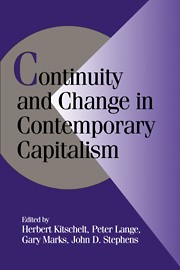Book contents
- Frontmatter
- Contents
- List of Contributors
- Preface
- Introduction
- PART I THE INTERNATIONAL SETTING FOR POLITICAL-ECONOMIC STRATEGIES
- PART II THE DYNAMICS OF DOMESTIC POLITICAL ECONOMIES
- 4 Divergent Production Regimes: Coordinated and Uncoordinated Market Economies in the 1980s and 1990s
- 5 The Political Economy of Europe in an Era of Interdependence
- 6 The Welfare State in Hard Times
- 7 Postwar Trade-Union Organization and Industrial Relations in Twelve Countries
- 8 Social Democratic Labor Market Institutions: A Retrospective Analysis
- 9 The Declining Significance of Male Workers: Trade-Union Responses to Changing Labor Markets
- PART III POLITICAL ECONOMY AND DEMOCRATIC COMPETITION
- PART IV CONCLUSION
- References
- Index
- Title in the series
7 - Postwar Trade-Union Organization and Industrial Relations in Twelve Countries
Published online by Cambridge University Press: 05 June 2012
- Frontmatter
- Contents
- List of Contributors
- Preface
- Introduction
- PART I THE INTERNATIONAL SETTING FOR POLITICAL-ECONOMIC STRATEGIES
- PART II THE DYNAMICS OF DOMESTIC POLITICAL ECONOMIES
- 4 Divergent Production Regimes: Coordinated and Uncoordinated Market Economies in the 1980s and 1990s
- 5 The Political Economy of Europe in an Era of Interdependence
- 6 The Welfare State in Hard Times
- 7 Postwar Trade-Union Organization and Industrial Relations in Twelve Countries
- 8 Social Democratic Labor Market Institutions: A Retrospective Analysis
- 9 The Declining Significance of Male Workers: Trade-Union Responses to Changing Labor Markets
- PART III POLITICAL ECONOMY AND DEMOCRATIC COMPETITION
- PART IV CONCLUSION
- References
- Index
- Title in the series
Summary
Ten years ago, when the volume Order and Conflict in Contemporary Capitalism (Goldthorpe 1984) was published, conventional academic wisdom regarding the future of trade unions and corporatism in western Europe was optimistic. As numerous contributors to that earlier volume emphasized, systems of industrial relations involving encompassing unions, in which authority was concentrated in either a small number of large industrial unions or in national confederations, had performed remarkably well in the decade after the first oil price shock of 1973. Most contributors to the Goldthorpe volume shared the view articulated by Peter Lange (1984) that unions could be thought of as playing an n-person prisoner's dilemma in which decentralized action among organizations resulted in collectively suboptimal outcomes. Unions would accept greater wage restraint collectively, the argument went, but not willingly concede acting individually. The prisoner's dilemma analogy suggested that the more encompassing the union movement, the greater the concentration among unions, and the more centralized the authority of the peak associations, the more likely it was that the collectively optimal cooperative solution could be obtained. David Cameron (1984), among others, provided support for this view with evidence showing that corporatism was associated with wage restraint and low strike rates, as well as with lower inflation and less unemployment than in noncorporatist OECD countries.
- Type
- Chapter
- Information
- Continuity and Change in Contemporary Capitalism , pp. 194 - 230Publisher: Cambridge University PressPrint publication year: 1999
- 39
- Cited by



